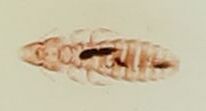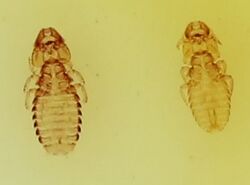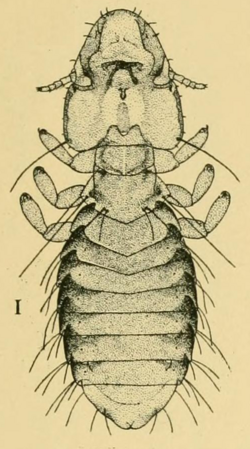Biology:Rallicola
| Rallicola | |
|---|---|

| |
| R. (R.) ortygometrae | |

| |
| Female and male R. (A.) gadowi | |
| Scientific classification | |
| Domain: | Eukaryota |
| Kingdom: | Animalia |
| Phylum: | Arthropoda |
| Class: | Insecta |
| Order: | Psocodea |
| Family: | Philopteridae |
| Genus: | Rallicola Johnston & Harrison, 1911 |
| Type species | |
| Nirmus attenuatus Burmeister, 1838
| |
| Synonyms[1][2] | |
| |
Rallicola is a genus of chewing louse. It is an ectoparasite of rails and other birds. It was named by Thomas Harvey Johnston and Launcelot Harrison in 1911. There are two subgenera aside from the nominotypical subgenus: Aptericola, whose species are found on kiwi birds, and Huiacola, a monospecific subgenus consisting of Rallicola extinctus, once found on the huia.
Taxonomic history
In 1866, Ferdinand Rudow circumscribed the Philopteridae genus Trabeculus with Trabeculus schillingi as its type species. In 1870, he created a new genus, Oncophorus with the same type species,[3] making it an objective junior synonym of Trabeculus. In 1880, Édouard Piaget added more species to Oncophorus.[4][5] He listed the author citation as "Rud." for Rudow in 1880,[4] but as "m." for mihi to indicate himself in 1885.[6][7]
Thomas Harvey Johnston and Launcelot Harrison created a new genus name, Rallicola, in 1911. A new name was needed as Oncophorus Piaget, 1880 and Oncophorus Rudow, 1870 had a senior homonym and senior synonym, respectively. They only included Oncophorus Piaget, 1880 species that parasitized rails and jacanas, leaving those that parasitized owls and hornbills to other genera.[7][8]
In 1915, Harrison split the genus into three subgenera: Rallicola (Rallicola) for species found on Rallidae (rails), Rallicola (Parricola) for those species found on Parridae, and Rallicola (Aptericola) for species found on Apterygidae (kiwis).[8] Harrison's 1916 list of Mallophaga species recognized sixteen valid species in Rallicola, one in Parricola and three in Aptericola.[9]
In 1990, Eberhard Mey described a new species, Huiacola extinctus and circumscribed a new genus, Huiacola for it.[10] Huiacola was subsequently classified as a subgenus of Rallicola.[11]
Type species
Johnston and Harrison designated "O. attenuatus N." as its type species.[7] This referred to a species Christian Ludwig Nitzsch named Philopterus (Nirmus) attenuatus,[12] which Édouard Piaget included in his 1880 taxonomy of Oncophorus.[4]:214–15
However, Nitzch's use of this name was nomen nudum as it was only accompanied with a queried indication to a previously-described taxon, namely Franz von Paula Schrank's 1781 description of Pediculus ortygometrae.[13][14] The name only became available in 1838 as Nirmus attenatus, when Hermann Burmeister provided the same indication to Schrank but without marking it as questionable.[15][16]
Synonyms
(As of 2017), six synonyms for this genus are recognized.[1][2] Hopkins and Clay designated Oncophorus bisetosus Piaget, 1880 as the type species of Piaget's Oncophorus.[17] Harrison listed the type species of his subgenus Parricola as "Rallicola (Parricola) sulcata Piaget",[8] i.e., Oncophorus sulcatus Piaget, 1880.
Three of its junior synonyms were named and circumscribed by M. A. Carriker, Jr. Carriker named the genus Furnaricola in 1944; his circumscription included its type species F. acutifrons (with two subspecies, F. a. acutifrons and F. a. subsimilis) as well as F. cephalosa, F. chunchotambo, F. heterocephala, F. laticephala, F. parvigenitalis, and F. titicacae, which were all described in the same work.[18] In a 1949 paper, he created the genus Epipicus for his new species E. scapanoides.[19] In another paper published in 1949, he named the genus Corvicola, which consisted of his newly-described species C. insulana.[20] By 1952, Hopkins and Clay had classified Furnaricola, Epipicus, and Corvicola as junior synonyms of Rallicola.[17] In a 1966 paper, Carriker defended the validity of Furnaricola as a distinct genus.[21] Roger D. Price ({{{2}}}) and K.C. Emerson ({{{2}}}) treated Furnaricola as its own genus in 1987,[22] but in 1993 Price and Dale Clayton concurred with Hopkins and Clay's synonymization.[23]
In 1982, Wolfdietrich Eichler (de) circumscribed the genus Psophiicola. Its type species is Liperus foedus Nitzsch in Giebel, 1866, which he transferred from Rallicola. This was the only species included in his circumscription.[24]
Hosts
In 1953, Theresa Clay reported that Rallicola have been found on 47 species across 25 genera of Rallidae.[25] Rallicola can also be found on birds in the Aramidae (limpkins), and Psophiidae (trumpeters) families.[26] The sole Huiacola species R. (H.) extinctus was found on the extinct huia bird, in the family Callaeidae.[10] Species in Aptericola are found on Apterygidae (kiwi birds).[27]
Distribution
The subgenera Huiacola and Aptericola are both endemic to New Zealand.[28] Species in the subgenus Rallicola can be found in North America,[29] the Pacific Islands, and New Zealand.[30] An undescribed Rallicola (Rallicola) species was recorded in the Galápagos Islands in 2013.[31]
Subgenera and species
Three subgenera are recognized, including the nominate subgenus.[1][2]
Rallicola
Rallicola Johnston & Harrison, 1911. Type species: Nirmus attenuatus Burmeister, 1838. Approximately 90 species, including:[2]
- Rallicola acutifrons (Carriker, 1944)
- Rallicola advenus (Kellogg, 1896)
- Rallicola chunchotambo (Carriker, 1944)
- Rallicola cuspidatus (Scopoli, 1763)
- Rallicola foedus (Nitzsch [In Giebel], 1866)
- Rallicola funebris (Nitzsch [In Giebel], 1866)
- Rallicola heterocephala (Carriker, 1944)
- Rallicola insulana (Carriker, 1949)
- Rallicola laticephala (Carriker, 1944)
- Rallicola ortygometrae (Schrank, 1781)
- Rallicola parvigenitalis (Carriker, 1944)
- Rallicola piageti Clay, 1953 - possibly coextinct; host New Caledonian rail[32]
- Rallicola scapanoides (Carriker, 1949)
- Rallicola titicacae (Carriker, 1944)
- Rallicola zumpti (Kéler, 1951)
 Rallicola guami Carriker, 1949 - probable conservation-induced extinction; host Guam rail[32][33]
Rallicola guami Carriker, 1949 - probable conservation-induced extinction; host Guam rail[32][33]
Aptericola
Aptericola Harrison, 1915. Type species: Rallicola (Aptericola) gadowi Harrison, 1915.[8] Four species:[2]
- Rallicola gadowi Harrison, 1915
- Rallicola gracilentus Clay, 1953
- Rallicola rodericki Palma, 1991
 Rallicola pilgrimi Clay, 1972 - conservation-induced extinction; host little spotted kiwi[32][33]
Rallicola pilgrimi Clay, 1972 - conservation-induced extinction; host little spotted kiwi[32][33]
Huiacola
Huiacola Mey, 1990. Type species: Huiacola extinctus Mey, 1990.[10] One species:[2]
References
- ↑ 1.0 1.1 1.2 Valim, Michel P.; Weckstein, Jason D. (2012). "A New Genus and Species of Philopteridae (Phthiraptera: Ischnocera) from the Trumpeters (Aves: Gruiformes: Psophiidae)". Journal of Parasitology 98 (4): 728–34. doi:10.1645/GE-3055.1. PMID 22448712. http://staging.fieldmuseum.org/sites/default/files/ValimandWeckstein2012JrnlParasit.pdf.
- ↑ 2.0 2.1 2.2 2.3 2.4 2.5 "Rallicola Johnston, T.H.; Harrison, L." (in en). http://phthiraptera.info/category/chewing-lice/philopteridae/rallicola.
- ↑ Rudow, Ferd. (1870). "Beobachtngen über die Lebensweise und den Bau der Mallophagen oder Pelzfresser, sowie Beschreibung neuer Arten". Zeitschrift für die Gesammten Naturwissenschaften 35: 475–476. http://reader.digitale-sammlungen.de/de/fs1/object/goToPage/bsb11046209.html?pageNo=487.
- ↑ 4.0 4.1 4.2 Piaget, É. (1880). "Oncophorus Rud.". Les pédiculines: essai monographique. Leide: E. J. Brill. pp. 213–223. https://books.google.com/books?id=bHxVAAAAcAAJ&pg=PA213.
- ↑ Kellogg, Vernon L. (1896). "New Mallophaga, I,—with special reference to a collection made from maritime birds of the Bay of Monterey, California". Proceedings of the California Academy of Sciences. Series 2 6: 68. https://biodiversitylibrary.org/page/16072341.
- ↑ Piaget, É. (1885). Les pédiculine: essai monographique. Supplément. Leiden. Leide: E. J. Brill. pp. 35–38. http://phthiraptera.info/content/les-p%C3%A9diculines-essai-monographique-suppl%C3%A9ment.
- ↑ 7.0 7.1 7.2 Johnston, T. Harvey; Harrison, Launcelot (1911). "Notes on some Mallophagan generic names". Proceedings of the Linnean Society of New South Wales 36 (142): 324. doi:10.5962/bhl.part.21901. https://biodiversitylibrary.org/page/3350656.
- ↑ 8.0 8.1 8.2 8.3 Harrison, Launcelot (1915). "Mallophaga from Apteryx, and their Significance; with a Note on the Genus Rallicola". Parasitology 8 (1): 88–100. doi:10.1017/S0031182000010428. http://phthiraptera.info/Publications/0182.pdf.
- ↑ Harrison, Launcelot (1916). "The Genera and Species of Mallophaga". Parasitology 9 (1): 126–127. doi:10.1017/S0031182000005989. https://biodiversitylibrary.org/page/47547392.
- ↑ 10.0 10.1 10.2 10.3 Mey, Eberhard (1990). "Eine neue ausgestorbene Vogel-Ischnozere von Neuseeland, Huiacola extinctus (Insecta, Phthiraptera)". Zoologischer Anzeiger 224 (1/2): 49–73. http://www.phthiraptera.info/Publications/0472.pdf.
- ↑ Palma 2017, p. 188.
- ↑ Nitzsch, Chr. L. (1818). "Die Familien und Gattungen der Thierinsekten (insecta epizoica); als Prodromus einer Naturgeschichte derselben". Magazin der Entomologie 3: 291. https://biodiversitylibrary.org/page/25414391.
- ↑ Schrank, Francisci de Pavla (1781). "1027. Ortygometrae, Wachtelköniglaus". Envmeratio insectorvm Avstriae indigenorvm: cum figuris. Avgvsta Vindelicorvm: Vidvam Eberhardi Klett et Franck. pp. 503–504. https://biodiversitylibrary.org/page/14965721.
- ↑ Clay, Theresa; Hopkins, G. H. E. (1954). "The Early Literature on Mallophaga (Part III, 1776–1786)". Bulletin of the British Museum (Natural History). Entomology 3 (6): 255–257. doi:10.5962/bhl.part.1053. https://biodiversitylibrary.org/page/2349488.
- ↑ Burmeister, Hermann (1838), Kaukerfe. Gymnognatha. (Erste Hälfte; vulgo Orthoptera.), Handbuch der Entomologie, 2, Berlin: Theod. Chr. Friedr. Enslin, p. 428, https://biodiversitylibrary.org/page/25467057
- ↑ Clay, Theresa; Hopkins, G. H. E. (1960). "The Early Literature on Mallophaga (Part IV, 1789–1818)". Bulletin of the British Museum (Natural History). Entomology 9 (1): 39. doi:10.5962/bhl.part.27551. https://biodiversitylibrary.org/page/2295124.
- ↑ 17.0 17.1 Hopkins, G. H. E.; Clay, Theresa (1952). "Rallicola Johnston & Harrison, 1911". A Check List of the Genera & Species of Mallophaga. London: British Museum (Natural History). pp. 317–321. https://biodiversitylibrary.org/page/50857232.
- ↑ Carriker 1944, pp. 83–97.
- ↑ Carriker 1949a, pp. 309–310.
- ↑ Carriker 1949b, pp. 1–4.
- ↑ Carriker, Jr., M. A. (1966). "A revision of the genus Furnaricola (Mallophaga) with descriptions of new species". Proceedings of the United States National Museum 118 (3532): 405–432. doi:10.5479/si.00963801.118-3532.405. https://biodiversitylibrary.org/page/7759940.
- ↑ Price, Roger D.; Emerson, K. C. (1987). "A New Species of Rallicola, Subgenus Parricola (Mallophaga: Philopteridae), from the Lotus Bird (Charadriiformes: Jacanidae) in New Guinea". Journal of Medical Entomology 24 (3): 281. doi:10.1093/jmedent/24.3.279.
- ↑ Price, Roger D.; Clayton, Dale H. (1993). "Review of the Species of Rallicola (Phthiraptera: Philopteridae) from the Woodcreepers (Passeriformes: Dendrocolaptinae)". Journal of Medical Entomology 30 (1): 35–46. doi:10.1093/jmedent/30.1.35. PMID 8433344.
- ↑ Eichler, Wolfdietrich (1982). "Notulae Mallophagologicae. XIII. Goliathipon nov. gen. und weitere neue Taxa der Gattungsstufe (Phthiraptera, Mallophaga)". Deutsche Entomologische Zeitschrift 29 (1–3): 84. doi:10.1002/mmnd.19820290114. https://www.biodiversitylibrary.org/part/244640.
- ↑ Clay 1953, p. 566.
- ↑ Emerson, K. C. (1955). "A Review of the Genus Rallicola (Philopteridae, Mallophaga) Found on Aramidae, Psophiidae and Rallidae". Annals of the Entomological Society of America 48 (4): 284–299. doi:10.1093/aesa/48.4.284.
- ↑ Palma 2017, pp. 186–188, 245.
- ↑ Palma 2017, p. 20.
- ↑ Wiseman, John Sumner (1959). The Genera of Mallophaga of North America North of Mexico with Special Reference to Texas Species (Thesis). Texas A&M University. pp. 247–248.
- ↑ Palma 2017, pp. 189–191.
- ↑ Palma, Ricardo L.; Peck, Stewart B. (2013). "An annotated checklist of parasitic lice (Insecta: Phthiraptera) from the Galápagos Islands". Zootaxa 3627 (1): 56–57. doi:10.11646/zootaxa.3627.1.1. ISBN 978-1-77557-126-1. PMID 25325090. https://www.researchgate.net/publication/267045993.
- ↑ 32.0 32.1 32.2 Beall, L. (1 November 2023). "Unwelcome Guests – Coextinction of Parasites". TheExtinctions. https://www.theextinctions.com/articles-1/unwelcome-guests-coextinction-of-parasites.
- ↑ 33.0 33.1 Rózsa, L.; Vas, Z. (2015). "Co-extinct and critically co-endangered species of parasitic lice, and conservation-induced extinction: should lice be reintroduced to their hosts?". Oxyx 49 (1): 107–110. doi:10.1017/S0030605313000628.
Works cited
- Carriker, Jr., M. A. (1944). "Studies in Neotropical Mallophaga – No. IV. New genera and species". Boletín de Entomología Venezolana 3 (2): 65–104. http://www.phthiraptera.info/Publications/3391.pdf.
- Carriker, Jr., M. A. (1949a). "Neotropical Mallophaga Miscellany. V. New genera and species". Revista Brasileira de Biologia 9 (3): 297–313. http://www.phthiraptera.info/Publications/0669.pdf.
- Carriker, Jr., M. A. (1949b). "On a collection of Mallophaga from Guam, Marianas Islands". Proceedings of the United States National Museum 100 (3254): 1–24. doi:10.5479/si.00963801.100-3254.1. https://biodiversitylibrary.org/page/15673924.
- Clay, Theresa (1953). "Revisions of the genera of Mallophaga.—I. The Rallicola-complex.". Proceedings of the Zoological Society of London 123 (3): 563–588. doi:10.1111/j.1096-3642.1953.tb00188.x.
- Palma, Ricardo L. (2017). Phthiraptera (Insecta) A catalogue of parasitic lice from New Zealand. Fauna of New Zealand. 76. Lincoln, New Zealand: Landcare Research. doi:10.7931/J2/FNZ.76. ISBN 978-0-947525-19-4.
Further reading
- Hopkins, G. H. E.; Clay, Theresa (1953). "Additions and corrections to the check list of Mallophaga". Annals and Magazine of Natural History. Series 12 6 (66): 434–448. doi:10.1080/00222935308654443.
- Kellogg, Vernon L. (1907). "11. Gens Oncophorus, Rudow". Mallophaga. Genera Insectorum. 66. Bruxelles: V. Verteneuil & L. Desmet. pp. 46–47. https://biodiversitylibrary.org/page/33733866.
Wikidata ☰ Q13654344 entry
 |


